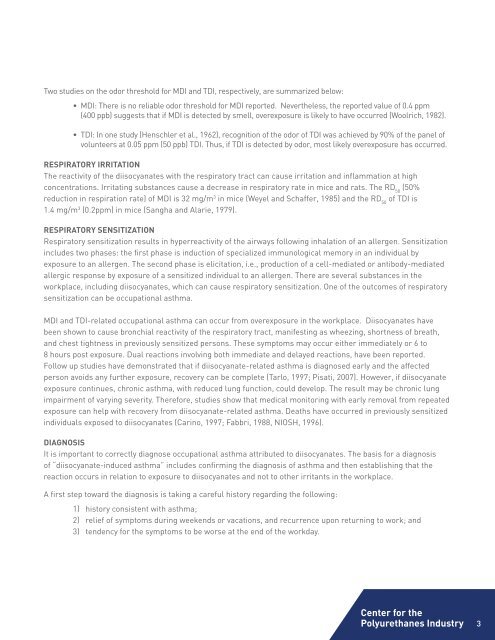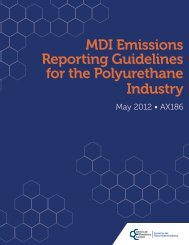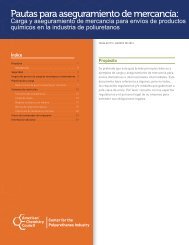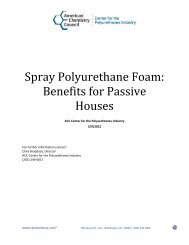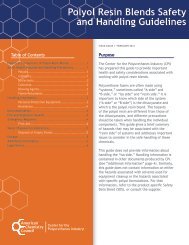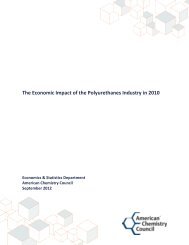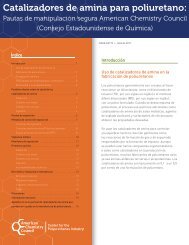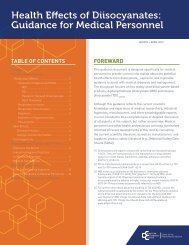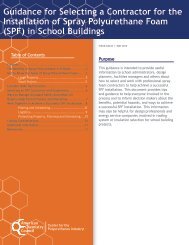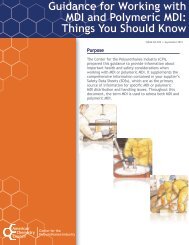Health Effects of Diisocyanates: Guidance for Medical Personnel
Health Effects of Diisocyanates: Guidance for Medical Personnel
Health Effects of Diisocyanates: Guidance for Medical Personnel
Create successful ePaper yourself
Turn your PDF publications into a flip-book with our unique Google optimized e-Paper software.
Two studies on the odor threshold <strong>for</strong> MDI and TDI, respectively, are summarized below:<br />
• MDI: There is no reliable odor threshold <strong>for</strong> MDI reported. Nevertheless, the reported value <strong>of</strong> 0.4 ppm<br />
(400 ppb) suggests that if MDI is detected by smell, overexposure is likely to have occurred (Woolrich, 1982).<br />
• TDI: In one study (Henschler et al., 1962), recognition <strong>of</strong> the odor <strong>of</strong> TDI was achieved by 90% <strong>of</strong> the panel <strong>of</strong><br />
volunteers at 0.05 ppm (50 ppb) TDI. Thus, if TDI is detected by odor, most likely overexposure has occurred.<br />
RESPIRATORY IRRITATION<br />
The reactivity <strong>of</strong> the diisocyanates with the respiratory tract can cause irritation and inflammation at high<br />
concentrations. Irritating substances cause a decrease in respiratory rate in mice and rats. The RD 50 (50%<br />
reduction in respiration rate) <strong>of</strong> MDI is 32 mg/m 3 in mice (Weyel and Schaffer, 1985) and the RD 50 <strong>of</strong> TDI is<br />
1.4 mg/m 3 (0.2ppm) in mice (Sangha and Alarie, 1979).<br />
RESPIRATORY SENSITIZATION<br />
Respiratory sensitization results in hyperreactivity <strong>of</strong> the airways following inhalation <strong>of</strong> an allergen. Sensitization<br />
includes two phases: the first phase is induction <strong>of</strong> specialized immunological memory in an individual by<br />
exposure to an allergen. The second phase is elicitation, i.e., production <strong>of</strong> a cell-mediated or antibody-mediated<br />
allergic response by exposure <strong>of</strong> a sensitized individual to an allergen. There are several substances in the<br />
workplace, including diisocyanates, which can cause respiratory sensitization. One <strong>of</strong> the outcomes <strong>of</strong> respiratory<br />
sensitization can be occupational asthma.<br />
MDI and TDI-related occupational asthma can occur from overexposure in the workplace. <strong>Diisocyanates</strong> have<br />
been shown to cause bronchial reactivity <strong>of</strong> the respiratory tract, manifesting as wheezing, shortness <strong>of</strong> breath,<br />
and chest tightness in previously sensitized persons. These symptoms may occur either immediately or 6 to<br />
8 hours post exposure. Dual reactions involving both immediate and delayed reactions, have been reported.<br />
Follow up studies have demonstrated that if diisocyanate-related asthma is diagnosed early and the affected<br />
person avoids any further exposure, recovery can be complete (Tarlo, 1997; Pisati, 2007). However, if diisocyanate<br />
exposure continues, chronic asthma, with reduced lung function, could develop. The result may be chronic lung<br />
impairment <strong>of</strong> varying severity. There<strong>for</strong>e, studies show that medical monitoring with early removal from repeated<br />
exposure can help with recovery from diisocyanate-related asthma. Deaths have occurred in previously sensitized<br />
individuals exposed to diisocyanates (Carino, 1997; Fabbri, 1988, NIOSH, 1996).<br />
DIAGNOSIS<br />
It is important to correctly diagnose occupational asthma attributed to diisocyanates. The basis <strong>for</strong> a diagnosis<br />
<strong>of</strong> “diisocyanate-induced asthma” includes confirming the diagnosis <strong>of</strong> asthma and then establishing that the<br />
reaction occurs in relation to exposure to diisocyanates and not to other irritants in the workplace.<br />
A first step toward the diagnosis is taking a careful history regarding the following:<br />
1) history consistent with asthma;<br />
2) relief <strong>of</strong> symptoms during weekends or vacations, and recurrence upon returning to work; and<br />
3) tendency <strong>for</strong> the symptoms to be worse at the end <strong>of</strong> the workday.<br />
Center <strong>for</strong> the<br />
Polyurethanes Industry<br />
3


